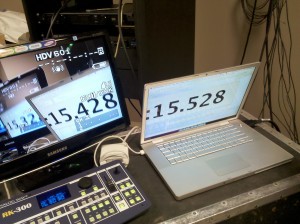When shopping for digital HD video equipment, the magic phrase is “3 frames or less”; supposedly, this is the magic number where the frame delay is not noticeable to us mere mortals. At a standard video rate of 30fps, a 3 frame delay would be exactly 100ms. When talking about pure digital video in a professional setting, it is CRAZY hard to get anything less than a 3 frame delay on your final output:
- 1st frame delay comes from the time difference between your camera optics and your digital output,
- 2nd frame delay comes from the time it takes your switch/mixer to process the video feeds,
- 3rd frame delay comes from your output source (monitor, projector, TV, etc).
This is basically the best case scenario, and if any of your equipment adds an extra frame in there anywhere, it becomes almost unusable in a live venue setting.
So, in a recent setup I’ve worked on we wanted to make sure that we were within that magical “3 frame” range, so we set up a little test. I built some timer software that would display the current time down to a precision of 1ms; we ran it on a computer and filmed the computer screen. We ran the camera through the video switch, and then the video switch out to a monitor sitting beside the computer. This way, we should have been able to see any delay introduced by the system. We bumped up the shutter speed on a still camera and snapped this picture:
Yay! The delay is EXACTLY 100ms; you don’t get better results than that. So, we hit our 3 frame cutoff mark; that’s great because it really is the best you could possibly hope to get (for the reasons above). But this left me scratching my head, and this is why:
That video was produced with all of the same equipment (in exactly the same configuration); so, believe it or not, this is a 3 frame delay (100ms). Obviously, 100ms is detectable by the human eye (yours detected it right?). From more empirical testing, we saw that 100ms is approximately equal to the time it takes to blink or close/open the palm of your hand. So, the moral of the story is, don’t let any video equipment sales/marketing person tell you that 3 frames is what you need to shoot for because you will never see the delay. You should shoot for 3 frames because it’s a best case scenario and…
That’s not the end of the story, and if I left it there I would be doing a disservice. While this short of a delay is detectable (with your eye), it is not always observable. See, when not standing directly in front of the screen we could not see the delay at all. For example, when filming someone speaking in the middle of the stage, there was no noticeable difference in what our ears heard and what our eyes saw on the screen. Even though, there is a real 100ms delay.
Then, because light travels faster than sound, it would even be possible to reverse any perceivable delay at certain distances. At room temperature, sound will travel approximately 110 feet in the 100ms time frame. Here’s what that means:
- At less than 110 feet from the screen, what you see will be ahead of what you hear. However, as I said earlier, the difference is hardly noticable.
- At 110 feet from the screen, what you see and what you hear will reach you at about the same time.
- Further than 110 feet, the images from the video will be ahead of the sound. Thus reversing the delay all together.
The real moral of the story: don’t make a butt of yourself complaining about a 3 frame delay that (while measurable and detectable) isn’t going to be noticeable in any real-world situation. Take it from somebody who knows first hand; this ruined a whole week of my life!

Nice!
How can it be the same equipment? In one photo, you are using a monitor. In the video, you are using a projector.
Projector scalers are notoriously slow.
Hey. Drop your video in to your NLE and do markers when your hand crosses the bottom of the screen. It will be a little rough, but you can count frames between your markers. As for what people can detect.. generally that’s with respect to lip sync, not with our ability to see the difference in two simultaneous images.
Thanks for posting the video, though! Frame delay.. the biggest challenge in professional imag, for sure!
Hey Lee, thanks for the comments, and yes I’m sooooo far behind with a reply :)
For what it’s worth, all of the results shown in the pictures and video above were reproducible whether the projector or the monitor were used. There were no real discernible differences between the two when the projector was at native resolution. I even have a picture somewhere with the projector image and monitor side-by-side (fed by the same video feed), showing the same time stamp (exactly 100ms behind the actual time).
Before the projector was hung, I also did a test with the cameras, dropped everything in Vegas Pro … low and behold, a 3 frame delay.
Moral of the story … I was being too critical of what I was seeing. I made the assumption that since I should should shoot for no more than a 3 frame delay … that I shouldn’t really notice such a delay (and was told as much from an actual professional A/V production company rep). Truth is, I could see it, and depending on the relative position of the live action to the projected image, the delay was annoying.
But, I’m over it now, it really isn’t that big of a deal in our venue anyway :)